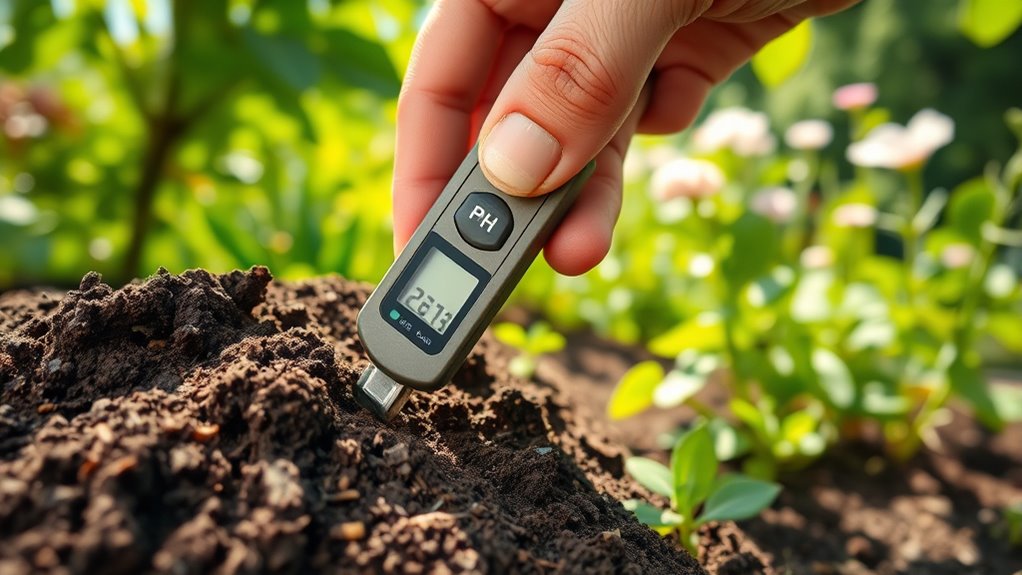To avoid common soil pH testing mistakes, make sure you sample properly from multiple spots and depths, avoiding overly wet or dry soil. Keep your testing tools clean, calibrated, and in good condition. Don’t rely on a single test—retest and track results over time for accuracy. Always interpret results with soil type and environmental context in mind. For tips on improving your testing approach, there’s more to discover that can boost your soil health.
Key Takeaways
- Inadequate sampling from limited spots or depths can produce inaccurate pH readings; take multiple, representative samples.
- Testing soil when it’s too wet or dry skews pH results; ensure optimal moisture levels before testing.
- Using expired or improperly stored testing tools, like test strips or probes, leads to unreliable measurements.
- Relying on a single test without repetition or proper record-keeping hinders accurate assessment and trend analysis.
- Ignoring soil type and environmental factors can cause misinterpretation; always consider context for correct pH management.
Skipping Proper Soil Sampling Techniques
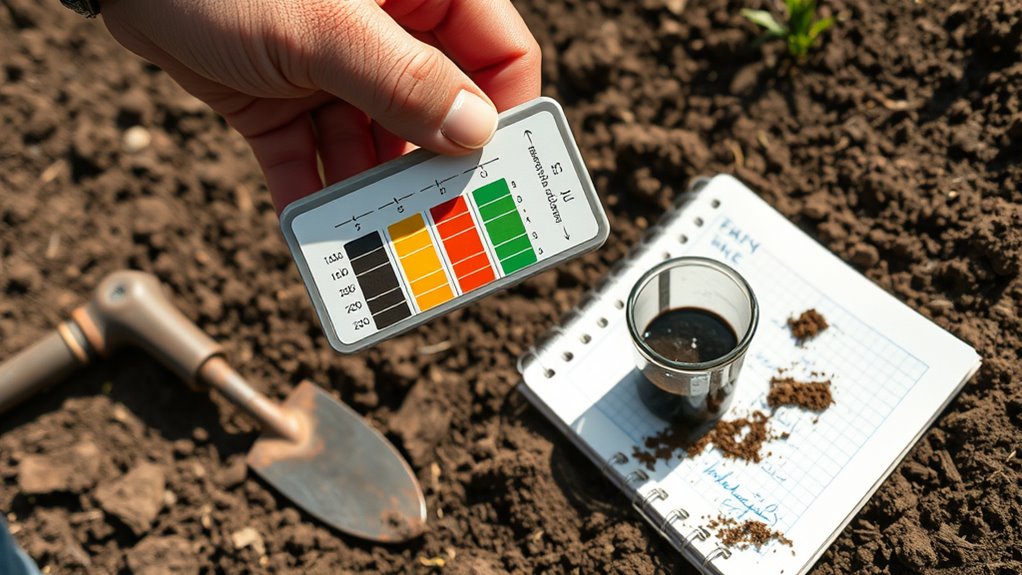
Skipping proper soil sampling techniques can lead to inaccurate pH test results, causing you to make poor decisions about soil amendments. When you don’t sample correctly, you risk missing variations in pH across your field, which can affect crop growth. To get reliable results, you should take multiple samples from different spots and mix them thoroughly. Avoid testing just one area or using surface samples alone. Proper sampling helps you identify pH imbalances that might require specific soil amendments. Additionally, understanding the pH variations can inform your crop rotation plan, as some crops prefer different soil conditions. Consistent sampling guarantees you’re making informed choices, preventing unnecessary amendments, and optimizing your soil’s health for better yields. Regular testing also provides insights into soil pH stability, ensuring long-term soil health management.
Testing Soil When It’s Wet or Too Dry

Testing soil when it’s too wet or too dry can lead to inaccurate pH readings that misguide your soil management decisions. Soil moisture directly affects test accuracy because water content influences how pH chemicals interact with the soil. If the soil is overly wet, excess water dilutes the sample, skewing results lower than the true pH. Conversely, when the soil is too dry, it may not release enough ions for an accurate reading, often resulting in falsely high pH values. To get reliable results, wait until the soil is moist but not soaked—similar to a damp sponge. Consistently testing under ideal moisture conditions ensures your pH readings are precise, helping you make informed decisions about amendments and plant health.
Using Dull or Inaccurate Testing Tools
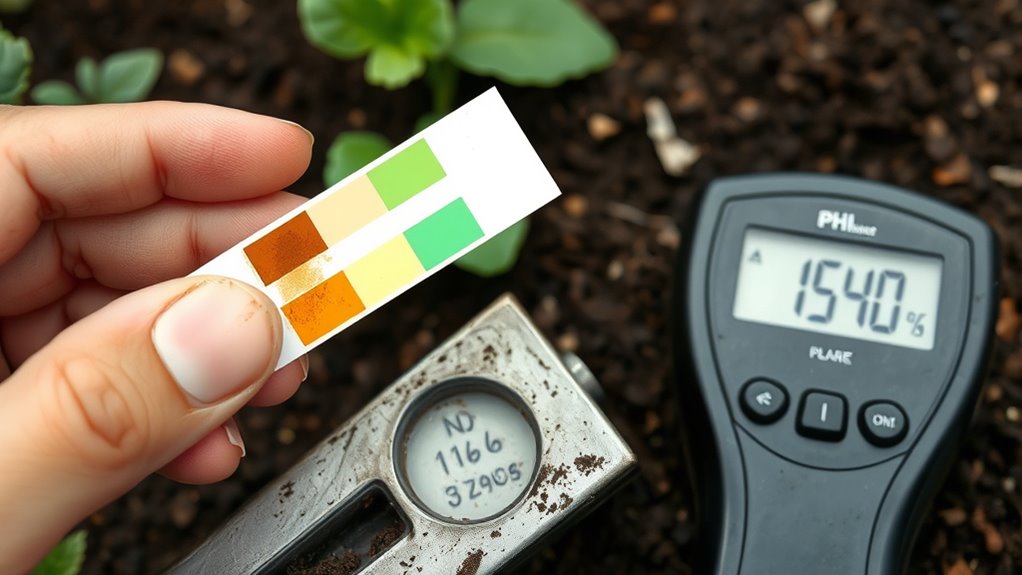
Using dull test strips or faulty calibration devices can lead to inaccurate soil pH readings. If your tools aren’t properly maintained or stored in ideal conditions, they may give false results. Always check your testing equipment regularly to guarantee your soil analysis stays reliable. Additionally, ensuring your testing methods incorporate proper calibration can significantly improve accuracy and consistency.
Worn-out Test Strips
Worn-out test strips can give you misleading soil pH readings, which can compromise your gardening decisions. Over time, exposure to moisture and sunlight causes test strip expiration, reducing accuracy. Using expired or dull strips can also lead to soil sample contamination, skewing results. Always check the expiration date before testing and discard strips if they’re past it. If the strips are dull or discolored, replace them immediately. Proper storage in a cool, dry place prevents deterioration. Regular maintenance and knowledge of test strip longevity ensure accurate results. Here’s a quick overview:
| Issue | Impact |
|---|---|
| Soil sample contamination | False pH readings, poor plant health |
| Test strip expiration | Inaccurate results, misguided decisions |
| Dull or worn strips | Reduced sensitivity, unreliable data |
| Improper storage | Shortened strip lifespan, inaccuracies |
Keeping your test strips fresh ensures precise soil pH measurements.
Faulty Calibration Devices
Faulty calibration devices can lead to inaccurate soil pH readings, even if your testing tools appear to be in good condition. Over time, calibration accuracy can decline if devices aren’t properly maintained, causing skewed results. Dull or damaged calibration probes, broken batteries, or debris buildup can all compromise device performance. Regular device maintenance is essential to guarantee accurate readings; this includes cleaning probes, replacing batteries, and recalibrating with fresh standards. Skimping on maintenance or neglecting calibration checks can give you false soil pH levels, leading to incorrect adjustments in soil amendments. To avoid this, establish a routine for device calibration and maintenance. Proper care of your testing tools ensures reliable results, helping you make informed decisions for healthy soil and plant growth. Additionally, understanding the soil pH testing process and how it impacts plant health can help you interpret results more accurately.
Improper Storage Conditions
If you don’t store your soil pH testing tools properly, they can become dull or inaccurate over time. Exposure to moisture, extreme temperatures, or dust can damage the electrodes, leading to faulty readings. Dull or contaminated probes won’t accurately measure soil pH, which affects your ability to select proper soil amendments. Inaccurate readings may cause you to add unnecessary lime or sulfur, disrupting pH buffering. Always keep your testing tools in a clean, dry case and avoid storing them near chemicals or fertilizers. Regularly calibrate your device and replace electrodes when needed. Maintaining proper storage guarantees your pH measurements stay precise, helping you make informed decisions for balanced soil conditions and ideal plant health. Incorporating proper storage practices will extend the lifespan of your tools and ensure consistent results.
Taking Samples From a Single Spot Only
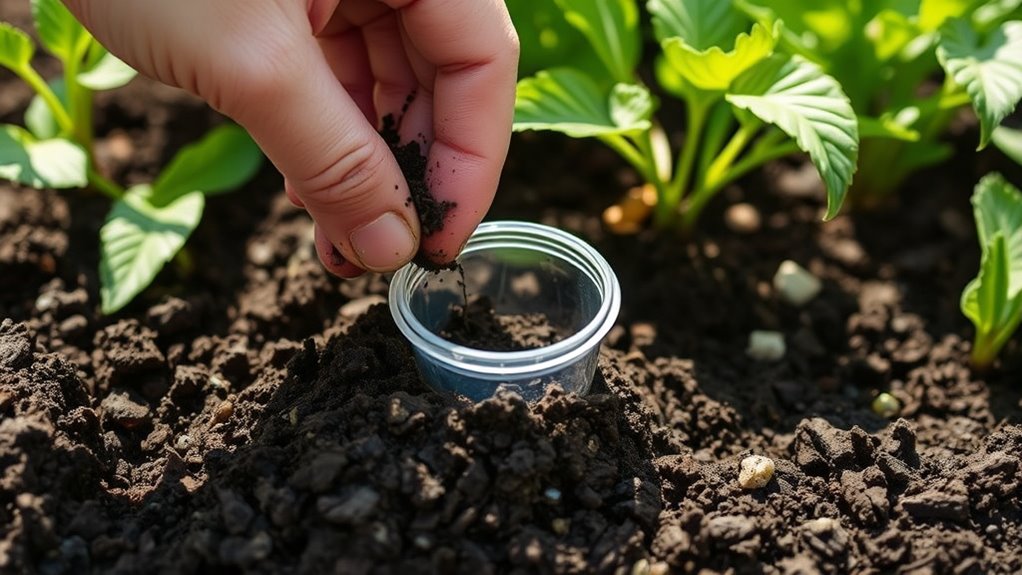
Taking soil samples from only a single spot can lead to inaccurate pH readings because soil properties often vary across a landscape. Relying on one location for your sample risks misjudging your soil’s true acidity or alkalinity. To get a more precise picture, avoid single spot sampling and instead gather multiple samples from different areas. This approach provides a more representative result for your entire garden or field. Remember, localized soil testing helps identify specific problem zones and guides better soil management.
Sampling multiple spots yields more accurate soil pH readings and better informs your soil management.
- Mix samples from various locations for a thorough analysis
- Don’t rely solely on one spot to determine overall soil health
- Use multiple samples to ensure accurate pH readings and effective adjustments
Ignoring the Importance of Sample Depth
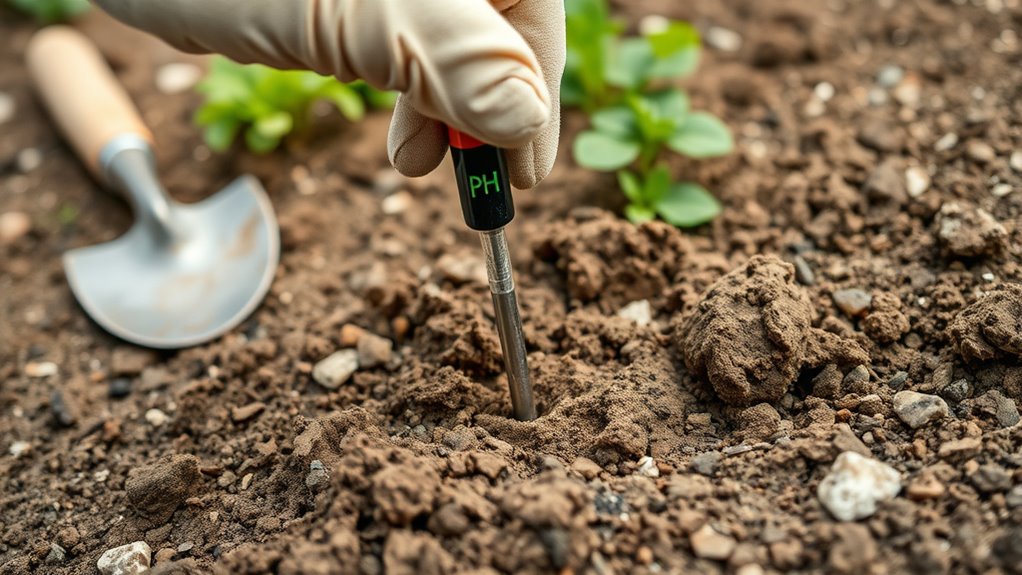
You might overlook how soil pH varies with depth, leading to inaccurate results. Surface samples often differ from subsoil, which can influence your plans for fertilization and planting. Testing at the correct depth guarantees you get an accurate picture of your soil’s true pH. Additionally, understanding the soil composition at different levels can help you make more informed decisions about amendments and crop choices.
Sample Depth Variability
Ignoring the significance of sample depth can lead to misleading soil pH readings because pH levels often vary with soil layers. This sample depth variability affects your understanding of nutrient distribution, which is vital for accurate soil management. If you test only at one depth, you might miss significant pH differences that impact plant health and fertilizer effectiveness. To avoid this, consider sampling from multiple depths, especially if your soil profile is layered or has recent amendments. Recognizing how pH varies with depth helps you make informed decisions about lime or sulfur application. Proper sampling techniques ensure you’re capturing a true picture of your soil’s pH and nutrient distribution, leading to healthier plants and better yields. Additionally, soil layering can cause pH differences at various depths, so understanding this concept is crucial for precise soil testing.
Surface vs. Subsoil Testing
Surface and subsoil samples often differ markedly in pH, so neglecting to test both can lead to incomplete or misleading results. Your root zone, where plants actively grow, interacts with both soil layers, each potentially having different pH levels due to soil layering and organic matter distribution. Testing only the surface might suggest the pH where roots are most active, but subsoil conditions can limit nutrient availability or hinder root development. Conversely, analyzing subsoil alone might ignore surface acidity or alkalinity that directly impacts seedling establishment. To accurately assess your soil’s health and adjust amendments properly, you need to test both layers. This thorough approach ensures your soil’s pH is suitable throughout the root zone, promoting healthier plant growth and avoiding misguided treatments. Additionally, understanding the best knitting patterns for olive green sweaters can help you create cozy garments suitable for seasonal weather changes.
Relying Solely on Home Test Kits
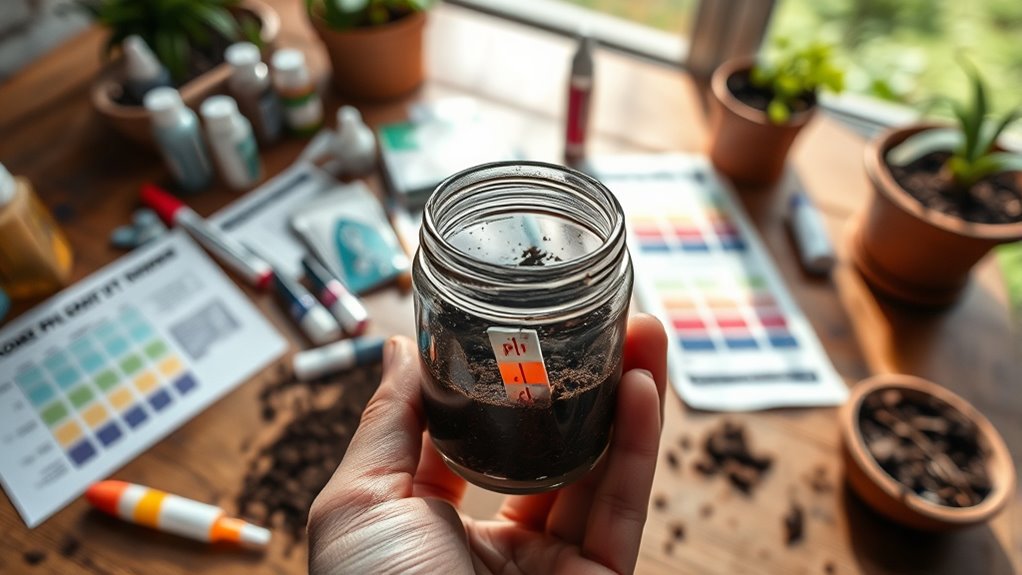
While home test kits are convenient, relying solely on them for soil pH testing can lead to inaccurate results. These kits often lack the precision needed to assess soil nutrient levels accurately. A false pH reading might cause you to apply unnecessary amendments or neglect needed ones, impacting plant health. To improve testing accuracy, consider supplementing home tests with lab analysis.
- Remember that soil conditions can vary, so test multiple spots for a thorough view
- Store test kits properly to prevent contamination and degradation of chemicals
- Use proper sampling techniques to avoid mixing soil layers and skewed results
Relying only on home kits can mislead you about your soil’s true pH and nutrient status. Combining methods ensures better decisions for your garden.
Misinterpreting Ph Results Without Context
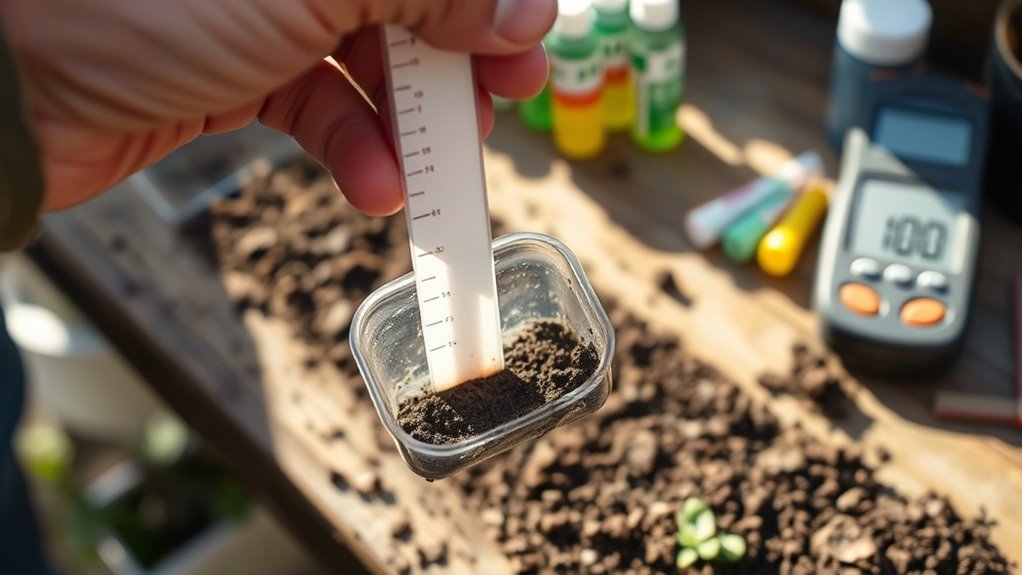
You might think a single pH reading tells the whole story, but that’s not the case. The pH scale has its limits, and environmental factors like rain or fertilizers can skew results. Also, timing matters—testing at the wrong moment can lead to misinterpretation without understanding these additional influences. Additionally, using proper testing equipment and techniques ensures more accurate readings, especially when considering factors like paint type and application method.
Ph Scale Limitations
Have you ever looked at a soil pH reading and assumed it tells the whole story? The pH scale has its limitations and doesn’t account for the complexity of soil health. A single pH value doesn’t reveal how soil nutrient availability or microbial activity might be affected. For example, two soils with the same pH can differ markedly in nutrient levels and microbial diversity.
- Soil pH influences nutrient solubility but doesn’t show nutrient deficiencies.
- Microbial activity can vary even within the same pH range, impacting plant growth.
- pH readings are just one piece of the puzzle; other factors also shape soil health.
Environmental Factors Influence
Environmental conditions such as moisture levels, temperature, and organic matter particularly influence soil pH readings, yet many people overlook their impact when interpreting results. These factors can give false impressions of soil health and affect plant growth. For example, dry soil may show higher pH, while moist soil can appear more acidic. Organic matter can buffer pH changes, masking true conditions. To understand these influences, consider this table:
| Factor | Effect on pH | Impact on Soil Health & Plant Growth |
|---|---|---|
| Moisture Levels | Alters pH readings temporarily | Affects nutrient availability |
| Temperature | Changes pH measurement accuracy | Influences microbial activity |
| Organic Matter | Buffers pH fluctuations | Enhances soil structure and fertility |
Ignoring these factors risks misinterpreting soil pH, leading to poor plant growth strategies.
Timing of Testing
Timing plays a crucial role in accurately interpreting soil pH results, yet many people overlook when they test. Testing at the wrong time can lead to misleading results, compromising soil test accuracy. To guarantee you’re getting reliable data, consider these factors for ideal testing timing:
- Test when the soil is moist but not waterlogged, typically after a few days without rain
- Avoid testing during extreme weather conditions, like after heavy rain or drought
- Conduct tests during the growing season’s active phase for more relevant pH levels
- Be aware that soil pH can fluctuate throughout the seasons, so testing at consistent times ensures more accurate comparisons.
Forgetting to Adjust for Soil Type and Composition
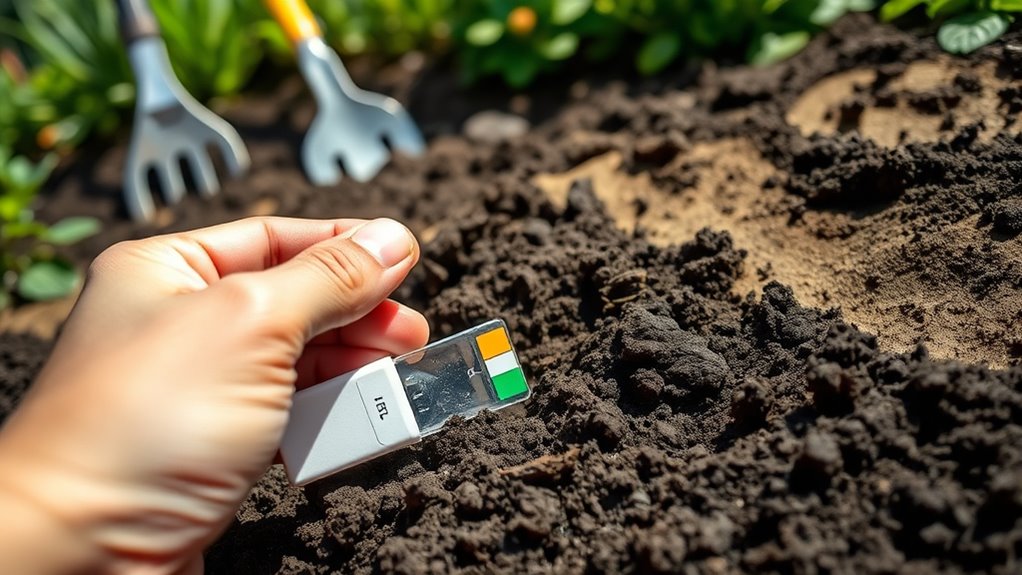
Failing to modify pH test results for your specific soil type can lead to inaccurate conclusions about its acidity or alkalinity. Different soils—clay, sandy, or loamy—interact uniquely with pH levels, affecting how you interpret test results. If you don’t consider soil composition, you might apply the wrong soil amendment, which can hinder plant growth and reduce crop yield. For example, sandy soils often drain quickly and may require more lime to raise pH, while clay soils retain moisture and might need different adjustments. Understanding soil interactions and adjusting your pH readings based on soil type ensures you’re making precise amendments. This way, you optimize nutrient availability, promoting healthier plants, better crop yield, and more efficient soil management. Always factor in your soil’s unique characteristics for accurate testing and effective results.
Not Repeating Tests to Confirm Results
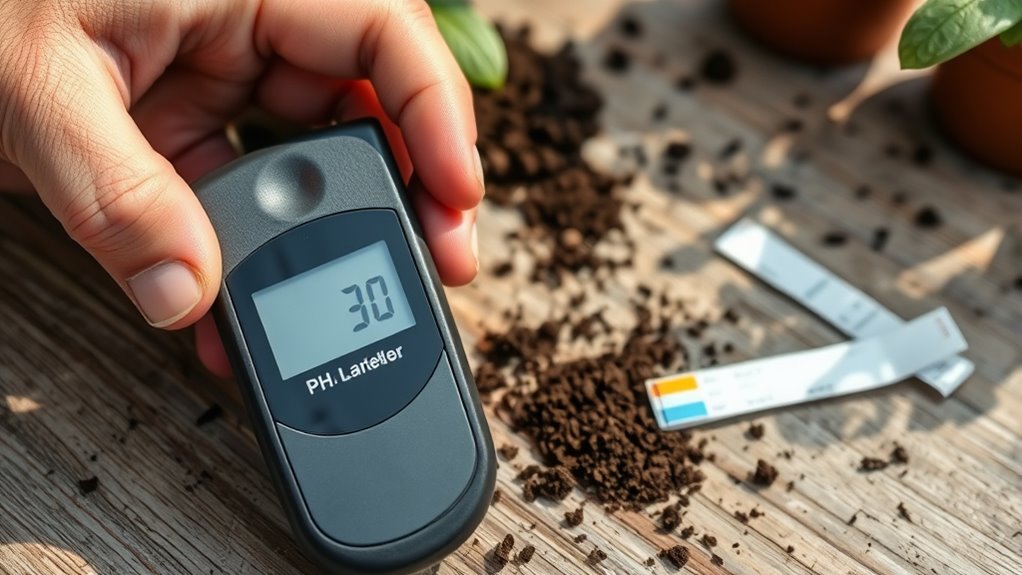
Since soil pH can vary slightly even in the same area, it’s important to repeat testing to confirm your initial results. Relying on a single test can lead to inaccurate test result confirmation, which affects your soil management decisions. To guarantee accuracy, use repeated testing strategies, such as testing multiple spots or retesting after a few days. This helps identify inconsistencies and confirms your pH levels. Keep in mind that soil conditions can change, so multiple tests provide a clearer picture of your soil’s true pH. Also, document each test to track trends over time. Remember, skipping repeated testing risks acting on false data, which can impact plant health and crop yields. Conducting regular soil tests ensures you stay informed about your soil’s health and make better-informed decisions. Confirm your results with consistent, repeated tests for reliable soil pH readings.
Failing to Record and Track Ph Changes Over Time
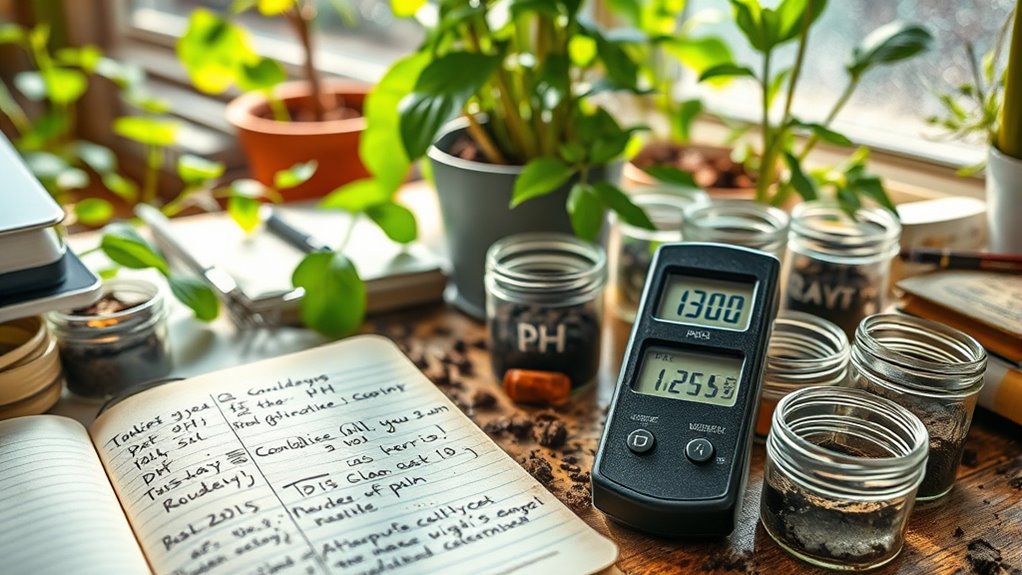
Tracking your soil pH over time is essential because soil conditions can fluctuate due to weather, fertilization, and crop cycles. By regularly recording pH levels, you gain a clearer picture of your soil’s health and can identify trends or issues early. Without tracking, you risk overlooking gradual changes that affect plant growth and soil balance. Failing to keep a record also hampers your ability to assess test accuracy—repeated measurements help confirm consistent results. Over time, this practice ensures you’re making informed decisions about amendments and crop management. Consistent tracking improves your understanding of how different practices impact soil health, preventing costly mistakes and ensuring your soil stays within ideal pH ranges for thriving plants.
Frequently Asked Questions
How Often Should I Test My Soil’s Ph for Accuracy?
You should test your soil’s pH at least once a year to make certain accurate soil nutrition and proper watering practices. Regular testing helps you catch pH imbalances early, so you can adjust amendments accordingly. If you notice changes in plant health or watering issues, test more frequently, every 3-6 months. Consistent testing keeps your soil balanced, supporting healthy growth and preventing nutrient deficiencies.
Can Soil Ph Vary Significantly Within My Garden?
Did you know soil pH can vary by up to two points across a single garden? Yes, within your garden layout, soil type variations cause significant pH differences. You might find some spots more acidic or alkaline than others, especially between sandy and clay soils. To get accurate readings, test multiple areas of your garden. This way, you can tailor amendments to each zone, ensuring healthy plant growth everywhere.
What Are the Signs of Incorrect Soil Ph for Plants?
If your plants show stunted growth, yellowing leaves, or poor flowering, you might have a pH imbalance. Incorrect soil pH can cause nutrient deficiency because nutrients become unavailable to plants when pH levels are off. You’ll notice these signs especially when plants struggle despite good watering and fertilizing. To fix this, test your soil regularly, adjust pH with amendments, and guarantee your soil stays within the ideal range for your specific plants.
How Do Soil Amendments Affect Ph Over Time?
Imagine you add lime to raise your garden’s soil pH. Over time, soil amendment effects like lime slowly neutralize acidity, helping maintain pH stability. This process can take months, so it’s essential to monitor pH regularly. Soil amendments gradually influence pH, either raising or lowering it, but their effects are not instant. Consistent testing guarantees your soil stays within the ideal pH range for healthy plant growth.
Is Professional Testing More Reliable Than Home Kits?
Yes, professional testing is generally more reliable than home kits because lab accuracy exceeds testing methods used in DIY kits. When you send your soil sample to a lab, experts analyze it with precise equipment, ensuring accurate pH readings. Home kits are convenient, but they can be affected by user error or less sophisticated testing methods, leading to less reliable results. For the best accuracy, opt for professional testing.
Conclusion
So, next time you skip proper sampling, test in the rain, or forget to record your results, just imagine your soil throwing a tantrum—pH out of whack, plants sulking, and your garden becoming a muddy mess. It’s like trying to read tea leaves with a spoon or guessing your way through a maze. Get it right, track your progress, and avoid turning your garden into a comedy of errors. Your plants will thank you!
